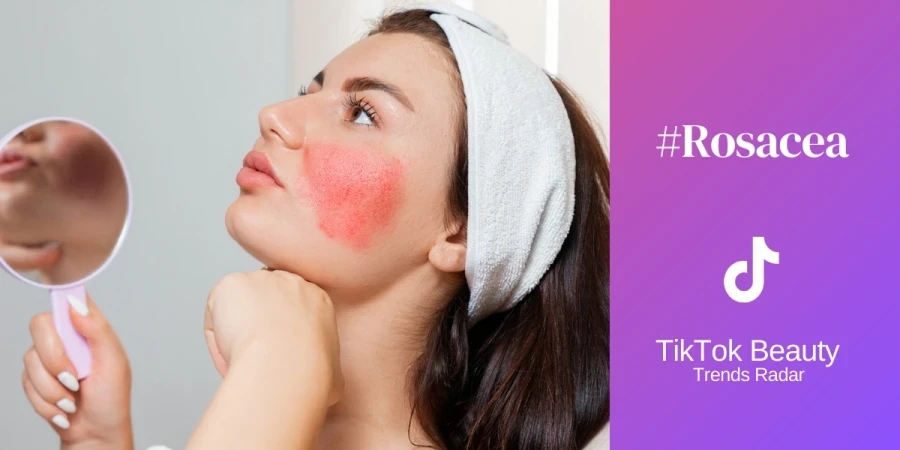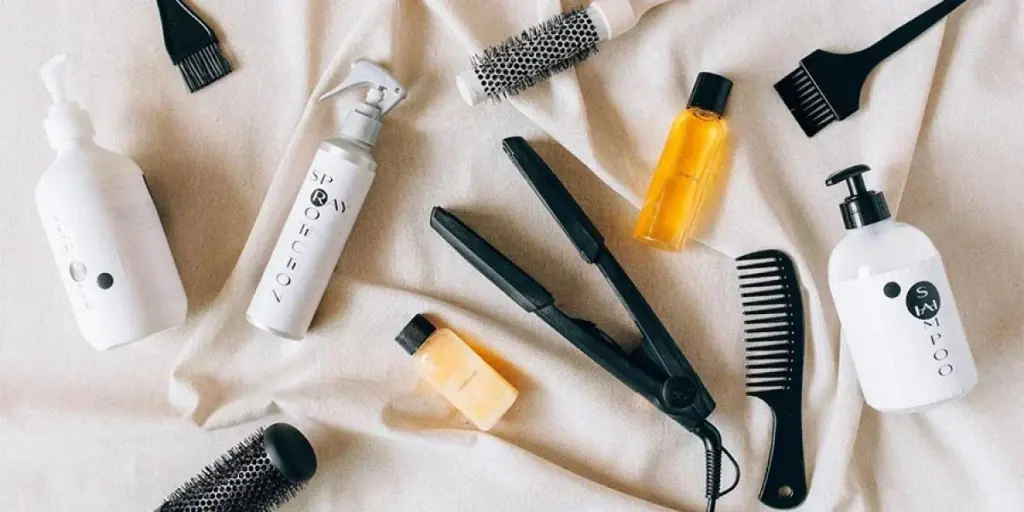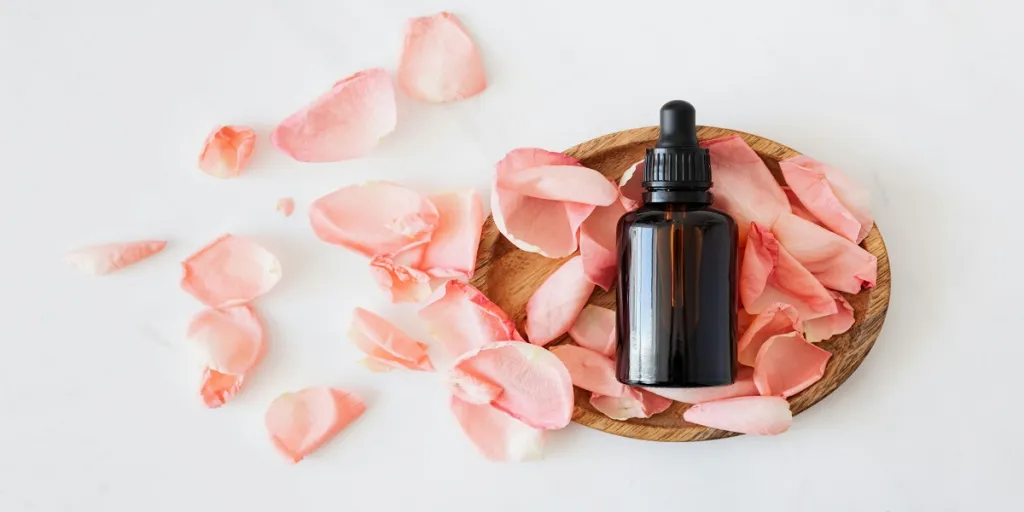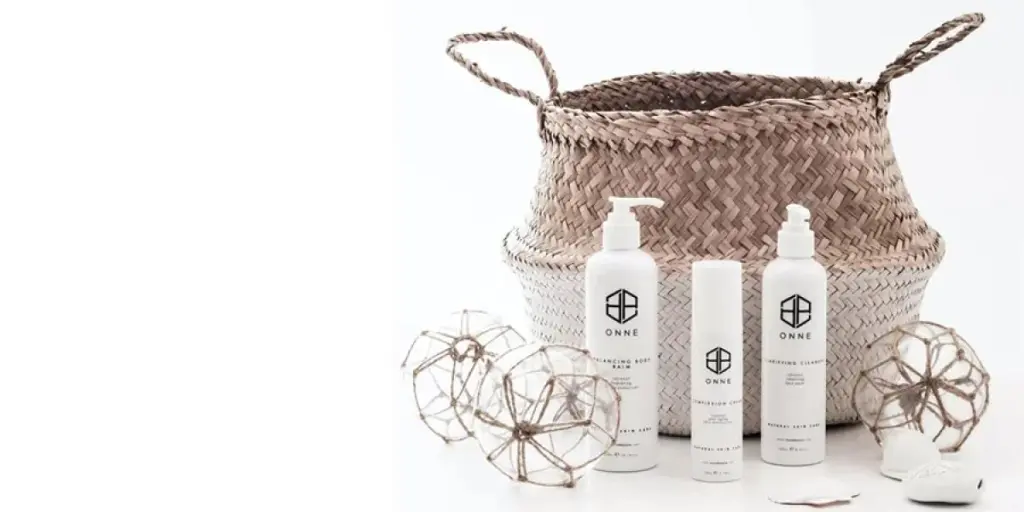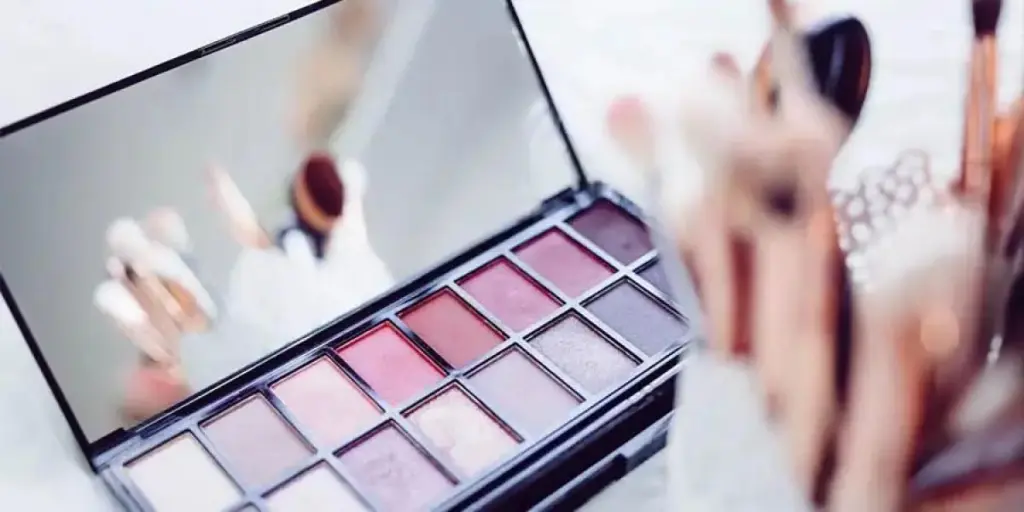In recent years, beauty conversations have been transformed by social media, with TikTok at the forefront. This time, the spotlight is on #Rosacea. Propelled by Rosacea Awareness Month in April, this once-overlooked skin condition is finally receiving the recognition it deserves. With millions of views and a rapidly growing community of creators, this digital movement is far more than a passing trend—it’s a powerful call for inclusivity, education, and innovation in skincare.
Conteúdo
● Understanding rosacea: More than just rosy cheeks
● The rise of #Rosacea on TikTok
● Debunking myths and raising awareness
● Product solutions for rosacea-prone skin
● Inclusivity in rosacea conversations
● Future outlook: Rosacea-focused innovations
Understanding rosacea: More than just rosy cheeks
Rosacea is a chronic skin condition that goes far beyond a simple blush or sunburn-like appearance. It’s a complex disorder that affects millions worldwide, with recent studies estimating a global prevalence of about 5.1%. While often misunderstood, rosacea is characterized by a range of symptoms that can significantly impact an individual’s quality of life.
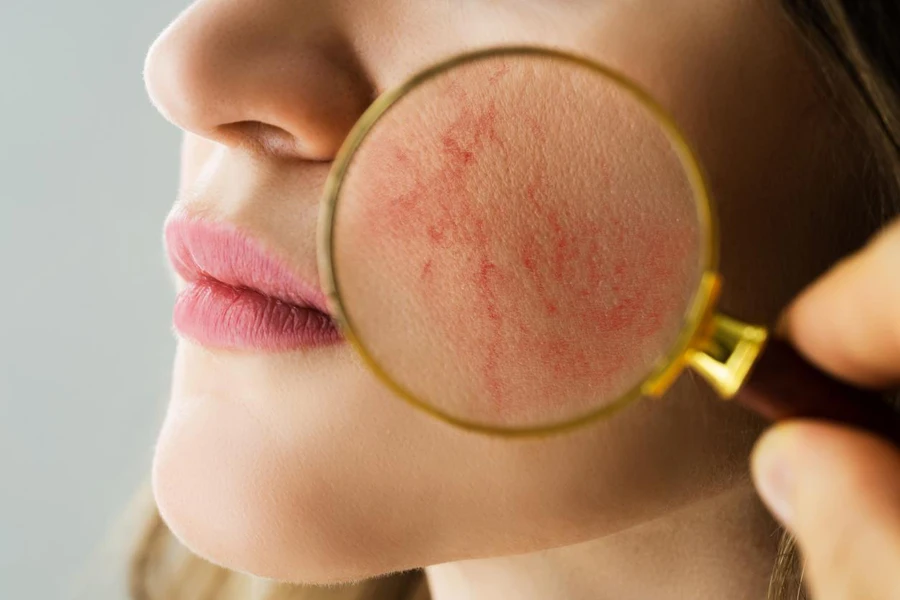
Definition and key symptoms:
Rosacea is an inflammatory skin condition primarily affecting the face. Its hallmark signs include:
- Persistent facial redness (erythema)
- Visible blood vessels (telangiectasia)
- Bumps and pimples
- Skin thickening, especially on the nose (rhinophyma)
- Eye irritation (ocular rosacea)
It’s important to note that rosacea is a relapsing condition, meaning symptoms can flare up and subside over time.
Quem é afetado?
Contrary to popular belief, rosacea isn’t limited to fair-skinned individuals of Northern European descent. Recent research has shown a more diverse distribution:
- Highest prevalence in East Asia (4%)
- Followed by Latin America (3.5%) and the Middle East (3.4%)
- People of mixed ethnicity showed the highest prevalence (4.3%)
Interestingly, the age group 25-39 showed the highest prevalence (3.7%), challenging previous notions that rosacea primarily affects older individuals.
Causas e gatilhos:
While the exact cause of rosacea remains unknown, several factors are thought to contribute:
- Abnormalities in facial blood vessels
- Reaction to microscopic mites (Demodex folliculorum)
- Predisposição genética
- Immune system irregularities
Common triggers that can exacerbate rosacea symptoms include:
- exposição ao sol
- Estresse
- Hot or cold temperatures
- Alimentos picantes
- Álcool (especialmente vinho tinto)
- Certos produtos para a pele
Understanding rosacea as a multifaceted condition is crucial for both those affected and the skincare industry. It’s not just about rosy cheeks – it’s a complex interplay of genetic, environmental, and physiological factors that require a nuanced approach to management and treatment.
The rise of #Rosacea on TikTok
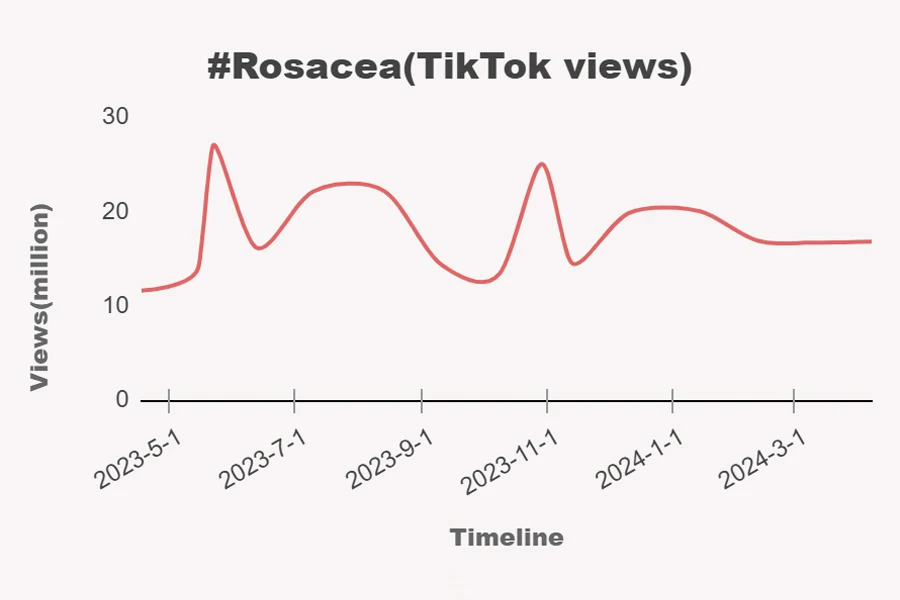
The #Rosacea hashtag has experienced a significant surge in popularity on TikTok over the past year. From April 2023 to March 2024, the trend has shown significant fluctuations, with views consistently ranging between 10 to 25 million per month. This pattern indicates a growing and sustained interest in rosacea among TikTok users, with particular momentum in the winter and early spring months.
The trend encompasses a variety of related hashtags, including #RosaceaProduct, #RosaceaSkincare, and #RosaceaAwareness. This diversity in content reflects the multifaceted nature of rosacea discussions on the platform, covering topics from personal experiences and skincare routines to product recommendations and educational content.
However, it’s crucial to note that while rosacea content is gaining traction, WGSN’s STEPIC* Index indicates a medium alignment and long lifespan for this trend. The trend shows stronger alignment with Society and Technology factors, suggesting potential for both social impact and technological innovations in rosacea management. This implies that while rosacea is currently a hot topic, its long-term influence on the skincare industry may be more gradual and sustained rather than explosive.
The consistent growth and engagement around #Rosacea on TikTok underscore the increasing awareness and desire for information about this skin condition. For businesses in the beauty and skincare industry, this trend represents an opportunity to address an underserved market segment, but with a strategic and measured approach to product development and marketing.
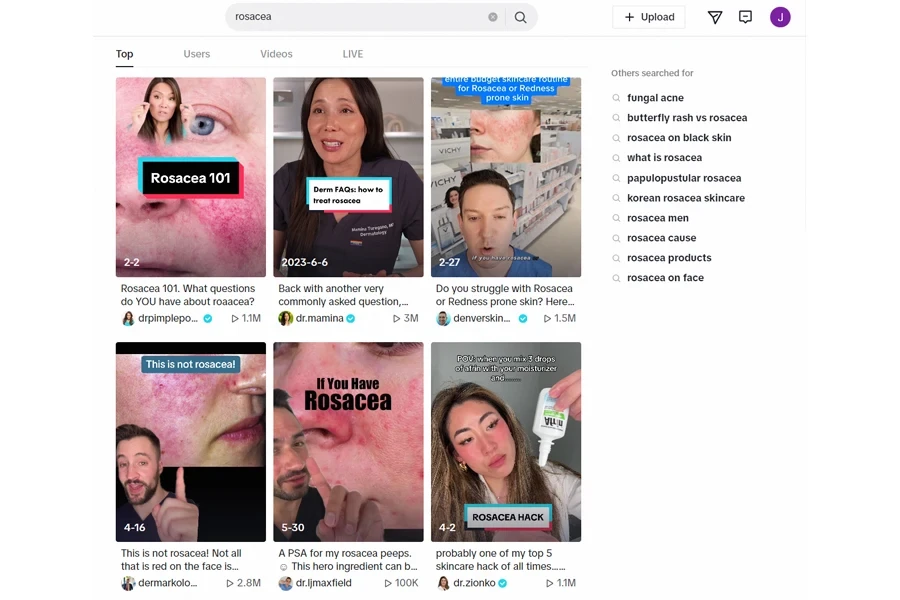
Debunking myths and raising awareness
The surge of #Rosacea content on TikTok has played a crucial role in debunking myths and raising awareness about this often misunderstood skin condition. As the WGSN analytics shows, there’s a consistent interest in rosacea-related content throughout the year, with significant spikes during certain months.
The cyclical pattern also suggests that interest in rosacea-related content is highest during spring and winter, possibly coinciding with changes in skincare routines and increased awareness during Rosacea Awareness Month in April.
The STEPIC* Index for #Rosacea provides valuable insights into the trend’s impact across various domains. Society emerges as the most prominent factor, indicating that the trend is deeply rooted in social conversations and personal experiences. This social aspect is driving awareness in several key ways:
- Personal stories shared by TikTok users are normalizing the condition and reducing stigma.
- Visual content is helping to illustrate the various manifestations of rosacea, aiding in earlier recognition and diagnosis.
- Discussions about common rosacea triggers are helping viewers understand and manage their condition better.
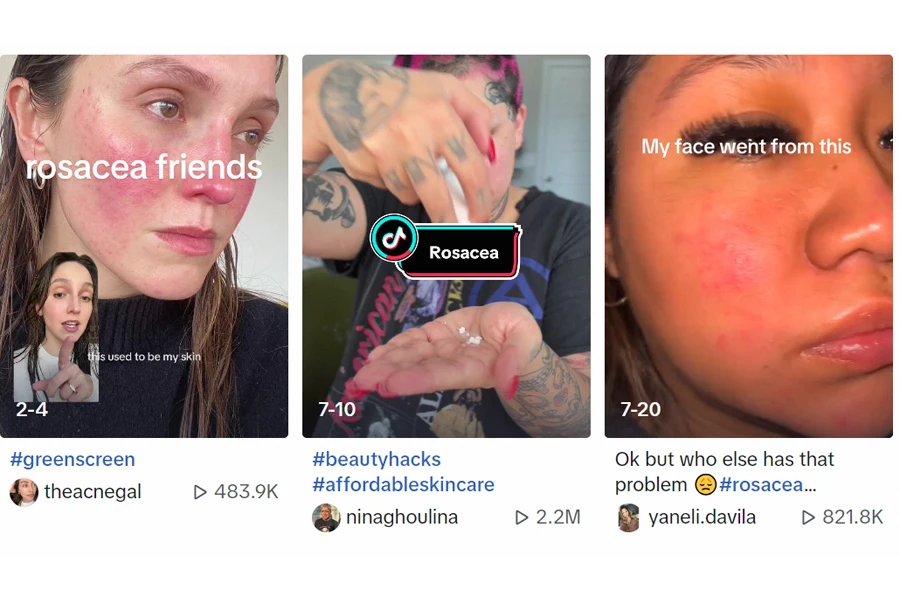
Content creators are addressing common myths, such as the belief that rosacea only affects fair-skinned individuals or older adults. By showcasing diverse experiences across different age groups and skin tones, social media is helping to paint a more accurate picture of who can be affected by rosacea.
While awareness is growing, there’s still room for expansion in rosacea-focused content and products. This presents an opportunity for brands and influencers to contribute meaningfully to the conversation, providing accurate information and innovative solutions for those affected by rosacea.
By leveraging TikTok’s visual format and its ability to reach millions, the #Rosacea trend is effectively dismantling long-held misconceptions and fostering a more informed, empathetic community around this skin condition. As the trend continues to grow and evolve, it has the potential to significantly impact how rosacea is understood and addressed in both social and medical contexts.
How to Build a Rosacea-Friendly Skincare Routine
Evite gatilhos
Pay attention to what exacerbates your rosacea symptoms. Common triggers include spicy foods, alcohol, extreme temperatures, and certain skincare ingredients like fragrances and alcohol. While some may find avoiding triggers can be helpful, others may find that avoiding triggers alone is not sufficient to manage their condition. And that’s when skin care solutions come in.
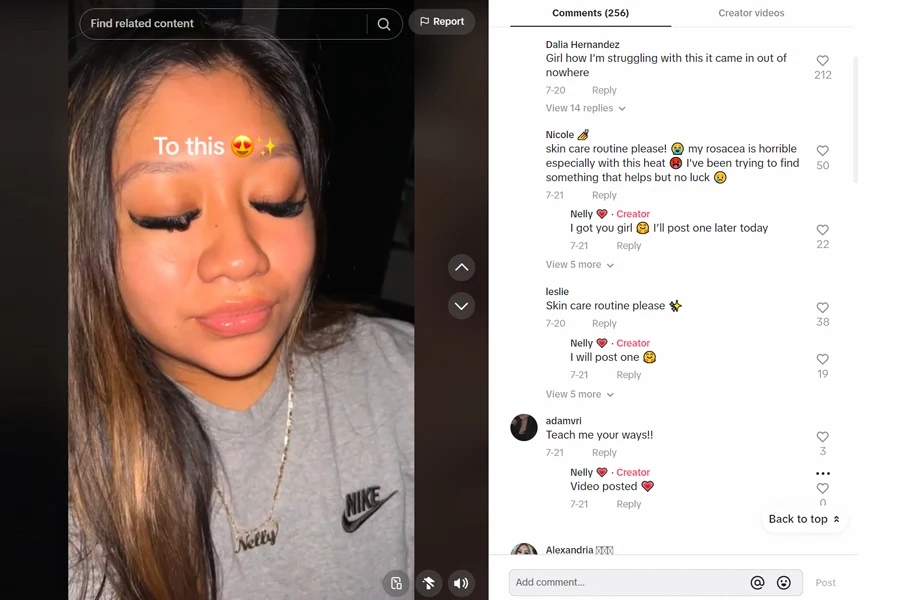
Limpeza suave
Start with a mild, non-foaming cleanser. Look for products free from harsh sulfates, fragrances, and alcohols. Cream or lotion cleansers are often recommended by dermatologists and TikTok skincare enthusiasts alike for their gentle yet effective cleansing properties.
Escolha o hidratante certo
Moisturizing offers several benefits such as repairing the skin barrier, supporting the skin’s microbiome, and maintaining pH balance. It helps reduce inflammation and can alleviate the itching and discomfort associated with rosacea. It also strengthens the barrier, preventing nerves from being exposed to the air. When choosing a moisturizer for rosacea-prone skin, dermatologists recommend opting for products that are non-comedogenic, pH-balanced, and contain ceramides to protect and repair the skin. Formulas with hyaluronic acid or azelaic acid can also be beneficial.
Treatment serums
Incorporate serums with ingredients known to calm rosacea symptoms. Niacinamide, azelaic acid, and vitamin C are frequently mentioned in #RosaceaSkincare videos for their anti-inflammatory and skin-barrier strengthening properties.
Moisturize effectively
Choose a moisturizer that hydrates without irritation. Look for products containing ceramides, hyaluronic acid, or glycerin. TikTok users often share their experiences with gel-cream formulations that provide hydration without feeling heavy on the skin.
proteção solar
SPF is crucial for rosacea-prone skin, as UV exposure can trigger flare-ups. Opt for mineral sunscreens with zinc oxide or titanium dioxide, which are less likely to cause irritation. Look for a product that contains SPF 30 or higher. Many TikTok creators emphasize the importance of reapplying sunscreen throughout the day, especially during peak sun hours.
Nighttime care
In the evening, consider using a reparative moisturizer or overnight mask to support skin healing. Some TikTok users share their positive experiences with products containing centella asiatica or colloidal oatmeal for overnight soothing.
Inclusivity in rosacea conversations
Expandindo a conversa
Representação Diversa: TikTok creators are challenging the long-held notion that rosacea only affects fair-skinned individuals. Content now showcases a wide range of skin tones affected by rosacea, reflecting the true diversity of those living with the condition.
Age Inclusivity: While rosacea is often associated with older adults, younger TikTok users are sharing their experiences with early-onset rosacea, broadening the age spectrum of the conversation.
Diversidade de gênero: The platform is helping to dispel the myth that rosacea is a “women’s condition” by featuring content from people of all genders discussing their rosacea experiences.
Perspectivas Culturais: TikTok’s global reach allows for sharing of cultural differences in rosacea perception, treatment, and management across different communities.
Interseccionalidade: Creators are discussing how rosacea intersects with other skin conditions or health issues, providing a more holistic view of skin health.
Impacto na indústria da beleza
While inclusivity in rosacea conversations is growing, there’s still significant room for expansion. This presents opportunities for:
- Developing skincare products that cater to a wider range of skin tones and types affected by rosacea.
- Creating marketing campaigns that reflect the diverse experiences of people with rosacea.
- Collaborating with a diverse group of influencers and dermatologists to provide varied perspectives on rosacea management.
Brands and content creators should focus on fostering supportive communities where individuals with rosacea can share experiences, tips, and emotional support. By embracing inclusivity in rosacea conversations, the skincare industry can better serve the diverse needs of those affected by this condition. As the trend continues to evolve, it has the potential to significantly impact how rosacea is understood, discussed, and addressed in both social and medical contexts.
Future outlook: Rosacea-focused innovations
Future Innovation Directions:
- Soluções personalizadas para cuidados com a pele: With the trend’s strong social alignment, we may see a rise in customized skincare routines and products tailored to individual rosacea triggers and symptoms.
- Produtos de proteção ambiental: Innovations in skincare products that offer better protection against environmental triggers like UV rays, pollution, and temperature changes are likely to emerge.
- Inclusive Product Formulations: Given the trend’s focus on inclusivity, future products may cater to a wider range of skin tones and types affected by rosacea.
Beauty brands should start with small-scale product launches or limited editions to test market reception. Collaborate with TikTok creators and dermatologists to develop and promote innovative solutions.
Conclusão
As the #Rosacea trend continues to evolve on TikTok, it’s likely to drive further innovations in the skincare industry. The cyclical nature of interest provides opportunities for targeted marketing and product launches, particularly during peak engagement periods in spring and winter.
By focusing on personalized, tech-enabled, and inclusive solutions, while considering environmental factors, the beauty and skincare industry can address the growing demand for effective rosacea management products and services. As this early-stage trend matures, we can expect to see a more diverse and sophisticated range of options for those dealing with rosacea.
